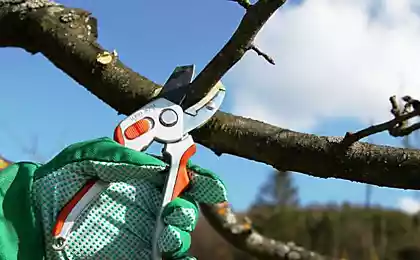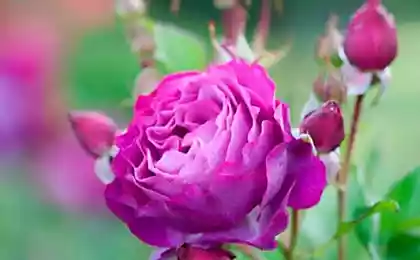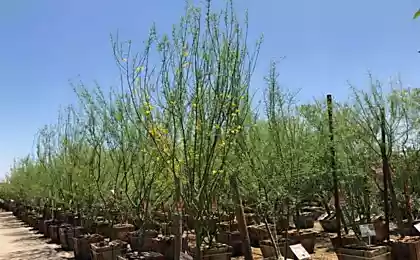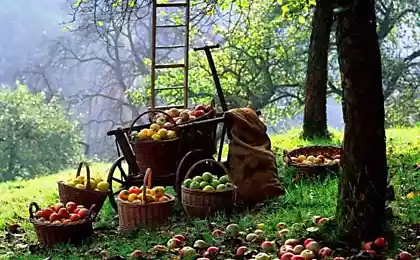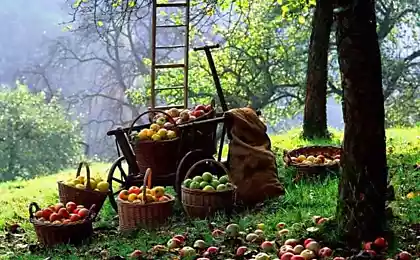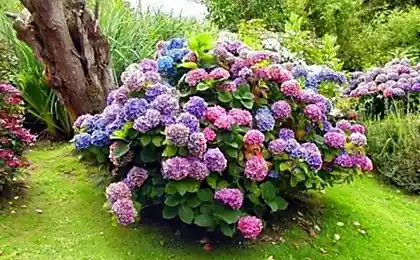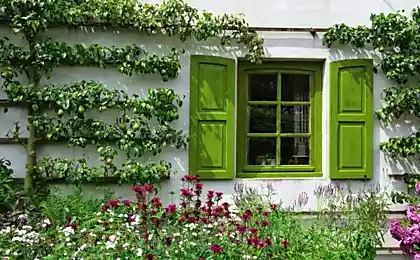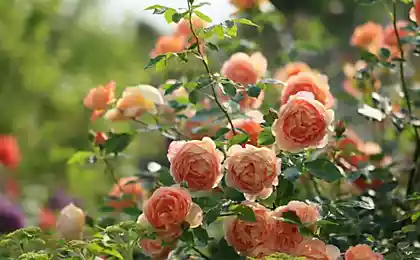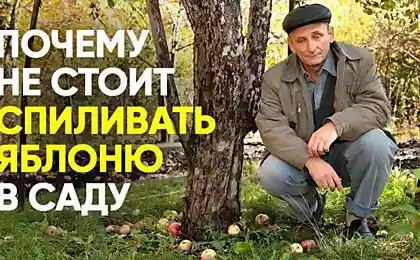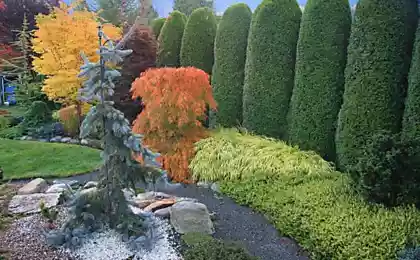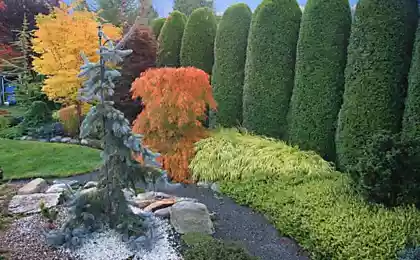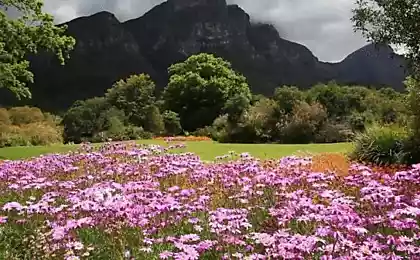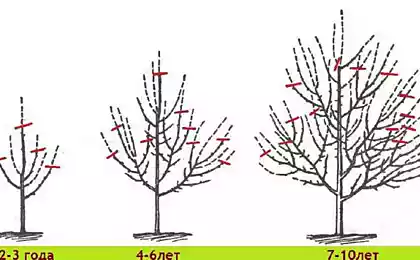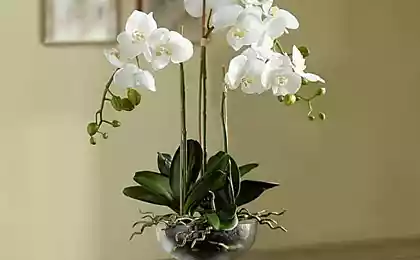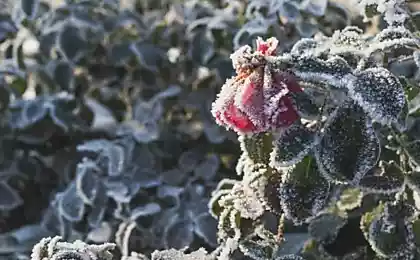721
How to trim a Apple tree
Cultural Apple from the wild differs primarily in trim. Without pruning the Apple tree grows wild and degenerate, the apples are small and tasteless. Why is this happening?
Pruning of garden trees is an individual creativity. But in this case there is strict rules and immutable laws. And all in order to ensure that every piece of paper unobstructed access to the sun and simultaneously molded to harvest crown.
You need to look deep processing of solar energy in a delicious, sweet Apple. In the presence of sunlight, carbon dioxide and water in the leaves of Apple trees is photosynthesis, which produces sugar. This sugar is transferred to the leaves, branches, trunks and roots as energy for respiration, growth and other life processes. But the main thing — it is passed to the fruit, actually what people, and grows an Apple tree.
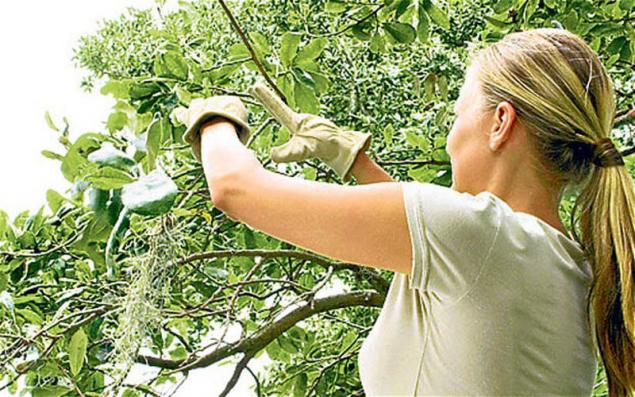
So why the need for pruning?Each leaf should only be exposed to direct or reflected sunlight for at least three hours a day, then he feeds himself and transfers energy in the form of sugar, fruit and other parts of the tree. If the sheet is irradiated less, he is transformed from a worker to the parasite feeds at the expense of other leaves, steals the sugar, which came to fruition. Yes and it starts to stick all kinds of diseases, he himself falls ill or passes disease to other leaves.
The more voluminous becomes the crown of the tree, the more sugar leaves on the growth of wood and less goes to apples. Agronomists say in such cases: "the Wood grow, fellow gardeners!" That need trimming, to regulate the flow of sugar: half growth and half fruiting.
By the nature of the growth and fruiting of Apple trees can be divided into the following types of varieties:the First type varieties with good pobegoobrazovatelnost ability. They have annual increment sufficient part of the kidney develops in different growth shoots that provides sufficient thickening of branches and strength of the skeleton of the tree. In the year of fruiting with fruit grow one or two buds, one or two short shoot. Fruit formation durable. This type of varieties include Borovinka, Parmen winter gold, Rennet Simirenko, etc.
Pruning Apple trees of the specified type varieties is the shortening of annual shoots by about one third. Trim type trim on a 4-5 year old or older wood with a diameter of 1 — 1.5 cm make once in 5-6 years.
Thin out the crown to lighten only at strong binding. The varieties with a pyramidal crown (Parmen winter gold) trim is pursued and the extension of the crown.
The second type is characterized by a main bearing at the ends of long branches of fine fruit sticks. Pobegoobrazovatelnost the ability to have strong growth weak, a large part of the growth buds remain dormant, the branches thicken slightly, wood skeleton fragile.
Bags of fruit in addition to fruit develops one to two escape, often forming a fork. Growth buds on fruit twigs usually do not germinate, the branches turn bare, slightly thicken.
Adult Apple trees when the crown becomes spreading boughs hanging down. To bend the ground due to better nutrition dormant buds grow shoots and much thicken the crown. Trees of this type ceased growth, need careful thinning of main branches forming the fork. To rejuvenate the branches are pruned for timber 3-4 years (1 to 1.5 cm in diameter). To this group the nature of the fruiting varieties are: Lithuanian Pepin, Pepin saffron, etc.
The formation of the crown in young trees of Apple and pear. At this age, pruning is carried out in order to help the tree to form a sufficient number of skeletal branches, place them in space so that each branch could develop in favorable lighting conditions, to acquire fruit formations.
The Apple-trees and pear, formed by sparsely-tier system, at the time of planting have a 3-4 strong side branches, aimed in different directions. Pruning and shaping of Apple trees is made starting from the first year after planting. Planted trees have cropped root system, meanwhile the above-ground part is saved. Naturally, this root system is unable to provide food and water to the aerial part, so the branches of the crown are shortened by 1/3 of the length from seedlings with shoots longer than 60 cm and half at more vigorous. Weak and lower branches are pruned less vigorous and top — more. The core conductor is cut so that its end was above the level of the skeletal branches to 30-40 cm in the crown If you have four or more branches, it is better to cut extra branches and shorten the rest a little bit. Pruning Apple trees is done prior to Bud break.
In the first year on short skeletal branches usually develop 2-3 escape, of which the upper left as conductors, and the lower pinch out over 4-5 leaves to turn them into fruit branches. In the next 5-6 years shorten all the main branches of the crown, but no more than 1/4 the length of growth so as to contribute to the formation only 2-3 more strong lateral branches skeletal and poluskeletnye type and a few to strengthen the development of anti-fouling twigs in the lower parts of the gains.
The growth of Apple trees forming the second tier of the main thick branches on the center conductor. To do this, select the most strong branches extending from the stem at an angle not less than 45°. In this case you need to try to branches of the second tier were located sparsely (for the bottom branches 40, for the upper 20 cm) in between the branches of the first tier. With good care every year, you can lay the 1-2 branch.
Second-order branches on the main skeletal branches of the first tier lay together with the second tier of branches of the first order, but at a distance of 35-40 cm from the trunk, and from the first to the second branches 15-25 cm in the formation of branches of the second and third order for the main skeletal branches of the first and second floor you have to follow the same rules.
Features of trim stone-fruit species. From stone fruit flower buds, giving only flowers on the side shoots. When severe pruning of the type of shortening or thinning the large wounds they heal very slowly or not grow, which is detrimental can affect the tree.
How to conduct a regulatory (support) pruning?The first years after the entry into fruiting branches usually grow quite strongly.
Therefore, the main task of trimming:
Begin pruning with the removal of broken, dry and diseased branches. If the crown will still be thickened, thinned it further. Thus it is better to remove 1-2, even in the larger branches, if this will solve the problem than to cut a large number of small branches. To hold the tree in the specified size of branches in the upper part of the crown cut to transfer to conveniently located branches horizontal, and the side — branches, oriented along the row. The latter is particularly important for flattened crowns.
With a very strong growth of branches should increase the number of fruit formations. The resulting rise in the fruiting will weaken the growth of shoots. When overloaded trees fruit buds during the cutting necessary to piece them together with fruit branches to remove to the abundant fruiting of the current year has not led to “rest” him next year. Moreover, they will sagomate crown. Therefore, it is necessary to remove the ring. Especially those that appear in the upper part of the crown near the place of cutting the center conductor. To remove less wood, instead of trimming more frequently to practise the breaking of the shoots. If the crown has free space, then fill it to the formation of branches on the basis of well-located gyroscope.
How to prune neglected trees?Pruning of young trees running, the crown of which is not out of specified size, starting with the isolation of the center conductor and determining the number and location of the main branches. Then thoroughly thinned crown. First remove branches dry, broken, frail, with a weak accretion of fruit formations. If that is not enough to remove a few strong healthy branches. Then spend the subordination of the remaining main branches among themselves and obedience to their guide.
When pruning neglected trees do not need to strive to create a perfect order at once, as this may require a very severe pruning. As a result, the wood may be greatly weakened or response will be strong volokovaya. In the first year, you can leave some thickening of the branches and not entirely clear may be the subordination of the main branches. Additional correction pruning can be implemented next year.
Pruning older neglected trees, the crowns of which are already beyond the fixed height and width, start height restriction and disclosure center. For this part of the Central conductor, or one or two branches, occupying his position, cut at a height of 18-2 m on successfully oriented to the periphery of the side branch. All other branches in the upper part of the crown is cut at a height of 2.5—W m side branch directed along the row. Lower, too drooping branches or carve on the ring, either cut to transfer to the branch, oriented upwards. This pruning in a given year, you can stop.
In the spring of next year, the crown thinned out according to common rules and techniques of pruning. Break out the summer tops that appear in the places of cutting the center conductor and larger branches. In further work with such a crown is to maintain optimal sizes, filling voids in the bare branches of the overgrown branches due to the formation of the emerging gyroscopes or enhance the growth of weak branches.
How to rejuvenate the crown or individual branches?With age, the number of branches, and accordingly points of growth and fruiting is becoming more. There comes a moment when moisture, mineral nutrients and products of photosynthesis is not enough to ensure the growth of strong shoots from vegetative buds, a high percentage of fruit set of generative buds, abundant fruiting and the establishment of flower buds for the harvest of the following year. Begins a progressive decrease in length of shoots, which indicates a weakening of the tree and the need to apply rejuvenating pruning, which aims to return the tree's ability to grow and to bring balance between growth and fructification and physiological equilibrium. This task is solved by the rejuvenation of the branches, that is, by cutting them in those places where the growth of branches strong enough.
Determine the cut in the outer annual rings.
The work order the following:
If you decide to do pruning in the area of the first, second or third layer, then, is not particularly looking at the length of annual growth in the cut, apply a similar pruning to all branches. Strong enough to consider growth (along the length of the annual rings) in the middle zone about 25, in the South—about 35 cm Slices is better to make the translation, even if this is a weak branch of a generative type.
To further carry out the regulation and rejuvenation of overgrown branches. First of all, remove unproductive puny generative branches. To further carry out the regulation and rejuvenation of overgrown branches. First of all, remove the feeler generative unproductive branches, then rejuvenate severely overgrown complex fruit-bearing branches and branched colchado. Make cuts on branches that are located in their middle part or closer to the base. When a large amount of all the work done in one year should not be. Rejuvenation of overgrown branches can be postponed for a year. In the summer it is necessary to observe the rejuvenated trees.
Spinning tops appear at the place of cutting the center conductor or larger branches, if there is no space for their growth, should break down.
Autumn audit of trees, which consists in determining the quantity and quality of harvest and length of growth will show, have been properly performed pruning. The gardeners, as a rule, pruning is not strong enough (weak growth). Then in the spring it is necessary to conduct additional rejuvenation of abandoned branches and fruit formations.
Large size crown is unreasonably large volume. Due to the developing of stripped branches in their deep parts of the leaf and fruit-bearing canopy move up and to the periphery. As a result, the yield per unit area of crown projection and volume is low, and the care of such trees becomes much more difficult. The situation can be greatly improved if you reduce the height of the crown to meters, and the width of the at least one direction of 2.5 m.
The reduced height is achieved by cutting the Central conductor at 1 ,8-2 m from the soil surface with the translation on the side branch.
If the place of the Central conductor took a few branches, respectively, is cut to transfer to branches focused to the periphery, each branch. This is achieved by opening the centre and improving the lighting conditions in the depth of the crown. With a strong exposure of the branches in the first year of this limited and.
If after clarification the centre of the crown there is still a lot of strong branches, at a height of about 2.5 m do crop them to transfer to the outer branches. In the same year or the next prune lower drooping branches so that the growth was pointing upward, and thin out the branches in the places of selenocosmiinae. In the summer, watching the trees and break the tops that do not have in the future space for growth.
Pay special attention to those that appeared in the ground cuttings to the center conductor and the branches in the upper part of the crown.
In free growth they can very quickly fill liberated from the branches of the space and left over the low crown is a new large crown of branches volchkovich. As a result, the growth of the lower part of the crown will further weaken. And, contrary to expectations, the height of the tree not only does not decrease, but will become even higher, not available for care and harvest.
If the tree is small and trim, respectively, is not very strong, but decline in height, it is necessary to limit its width from two opposite sides. When the orientation of the row from North to South the length of the branches restricted to the East and West sides. The easiest way is achieved by pruning of the branches to transfer to the branch directed along the row. Moreover, the length of the branches in the lower part of the crown should be slightly larger than the top. In General, the plane of the slices from the bottom up should be placed at an angle of 15-20°. This will prevent the lag in the growth of the lower branches, and strengthening upper: height will be proportional.
The taking of the crown can be restricted to reduced height — get a horizontally flattened crown. If pruning to hold both sides of the crown, its width will decrease and the crown will be flattened vertically. You should not attempt to do all the work in one go. If the trees are high and old, to bring them to any of the above sizes would take 2-3 and sometimes 4 years.
Whether always it is necessary to correct the already established crown?
No, not always. The crown of young trees is easily given to the reformation, but the more they age the more they run, the harder it is to do this work. In such cases, should be necessary: to reduce the height, to achieve a balance between growth and fruiting, not paying attention to either the location or the subordination of the branches. Krone may be one-sided and tilted the barrel, it is important to have the fruits, and the tree did not occupy unnecessarily large area and space of the garden.
When to severe pruning of trees under harvest or under a lean year?
If in the past year have resulted in a large number of flower buds (this can be easily identified in the spring during the inspection of trees), pruning, even strong, can be carried out safely. Mindful of the fact that adult trees only from 2 to 10% of the flowers can bear fruit (the other 90-98% will fall off), cropping under a crop year it is necessary to deliberately remove a certain number of flower buds along with the fruit branches, on which they are located. This will reduce the frequency of fruiting.
With a small number of flower buds pruning should be carried out carefully and try to save, maybe more. The presence of fruit on the tree will contain the intensity of laying of flower buds for the harvest of next year, which is very desirable, especially when the periodicity of fruiting. When pruning is necessary to consider what the fruit branches is the main part of the harvest: if on the branches — pruning a noticeable effect on the number of fruits will have; if at the ends of vegetative branches and fruit on the twigs, then the shortening can be significantly reduced fruit set, which in the presence of a large number of flower buds is desirable, and a small number of them undesirable.
When and how to prune trees affected by frost?
First of all it is necessary to determine the nature and degree of freezing. Cut branches kept in container of water in a warm room. The number of Bud break to determine the percentage of freezing, and the color of the wood on the cut — degree of freezing of branches. At low freezing color of the wood yellow, and strong brown (pear and black). The bark on the trunk and branches with sunburn and morozovoy first reddens, and then when desiccation formed a depressed areas. At low freezing pruning is carried out in the usual terms, subject to the General rules. The necessary amendments can be done in the next year or in the summer if there is drying of the branches or parts of them. Fully frost-injured branches is embedded in the ring, but if froze solid only the upper part, to healthy wood. When the average degree of freezing of branches pruned stronger than we would have when trimming healthy trees. This is necessary in order to enhance the growth of new shoots near the base of the branches, as the branches podberesye fragile and at great length, easy to break off under its own weight.
Pruning severely damaged trees during the year of freezing. It is necessary to postpone this work until next year, when sprouted new branches, you can determine where the crop will be effective. It is possible that pruning is not required. First, the tree could start to bloom at the expense of stocks, and in the middle of summer to partially or completely dry up. In the complete freezing of the aerial system to the level of snow cover young trees are cut back growth. Of the branches that emerged above the site of inoculation, choose the most strong and on its basis form a new crown.
When winterkill overhead system in older trees it is better to uproot and plant new. Partial freezing severe pruning should be done in the same place on each branch, where there are new branches or tops. Based on the gyroscopes it is possible to form both core and branches overgrowing. When pruning heavily podmerzshie trees regular pruning can be neglected. It is necessary to leave all the healthy branches, below them sleeping on the leaves contributed to the rapid growth of new layers of wood. After restoring the volume of the crown can be carried out thinning it, and the normalization of the main and overgrown branches. When pruning frozen trees is necessary to ensure that on the trunk and main branches there were no large wounds on the same level as branch or have the crown (if such wounds on the trunk) can shrink. More carefully than usual, need to cover wounds on podmerzshie trees.
In what time frame it is better to trim fruit trees?The young trees during the period of crown formation it is best to trim in the dormant period, for 3-4 weeks before the start of the growing season. This will provide better growth of shoots. Adult fruiting trees can be cut at any time — winter, spring before and after the start of the growing season until the end of flowering. Winter pruning is definitely acceptable in southern parts of the country. In the middle lane it is dangerous: when severe frosts on the eve of the trimmed trees can freeze. Pruning after the beginning of the growing season preferred with a significant reduction of the crown. In this case, the regeneration is not as strong and less will be formed Volchkov. Rejuvenation of trees is best done no later than Z—4 weeks before the start of the growing season, as it is important to enhance growth. Clipping dry, broken, thickening of the branches of adult trees can be done anytime of the year.
How to determine the correct cropping?
For the life of the tree it may have to be cut. In order not to repeat the mistakes, it is necessary to evaluate the results of the previous crop and before each subsequent. For this we need to examine the cut to determine the overgrowth of wounds and reaction to pruning. If the wound heals poorly or unevenly, then the technique of making the cut was not correct. It is necessary to amend. If the response to pruning (e.g., strength and direction of growth of new branches) is not within the plan, then an error occurred that must be corrected on this branch or to consider in a similar situation and make the appropriate adjustments.
What are the features of tree pruning in dense and very dense planting?
In a dense location of trees is impossible to form a crown for each of them separately. In this case, pruning is carried out throughout crown solid number, not paying attention to which branch and at what trunk is Important that has not been stripped branches, thickened areas with poor light regime was quite strong shoot growth and there were branches overgrowing. In need for a high fruiting quantity. Width across the series and crown height should be between 2-2.5 M. published
P. S. And remember, only by changing their consumption — together we change the world! ©
Join us in Facebook , Vkontakte, Odnoklassniki
Source: secretdachi.ru
Pruning of garden trees is an individual creativity. But in this case there is strict rules and immutable laws. And all in order to ensure that every piece of paper unobstructed access to the sun and simultaneously molded to harvest crown.
You need to look deep processing of solar energy in a delicious, sweet Apple. In the presence of sunlight, carbon dioxide and water in the leaves of Apple trees is photosynthesis, which produces sugar. This sugar is transferred to the leaves, branches, trunks and roots as energy for respiration, growth and other life processes. But the main thing — it is passed to the fruit, actually what people, and grows an Apple tree.

So why the need for pruning?Each leaf should only be exposed to direct or reflected sunlight for at least three hours a day, then he feeds himself and transfers energy in the form of sugar, fruit and other parts of the tree. If the sheet is irradiated less, he is transformed from a worker to the parasite feeds at the expense of other leaves, steals the sugar, which came to fruition. Yes and it starts to stick all kinds of diseases, he himself falls ill or passes disease to other leaves.
The more voluminous becomes the crown of the tree, the more sugar leaves on the growth of wood and less goes to apples. Agronomists say in such cases: "the Wood grow, fellow gardeners!" That need trimming, to regulate the flow of sugar: half growth and half fruiting.
By the nature of the growth and fruiting of Apple trees can be divided into the following types of varieties:the First type varieties with good pobegoobrazovatelnost ability. They have annual increment sufficient part of the kidney develops in different growth shoots that provides sufficient thickening of branches and strength of the skeleton of the tree. In the year of fruiting with fruit grow one or two buds, one or two short shoot. Fruit formation durable. This type of varieties include Borovinka, Parmen winter gold, Rennet Simirenko, etc.
Pruning Apple trees of the specified type varieties is the shortening of annual shoots by about one third. Trim type trim on a 4-5 year old or older wood with a diameter of 1 — 1.5 cm make once in 5-6 years.
Thin out the crown to lighten only at strong binding. The varieties with a pyramidal crown (Parmen winter gold) trim is pursued and the extension of the crown.
The second type is characterized by a main bearing at the ends of long branches of fine fruit sticks. Pobegoobrazovatelnost the ability to have strong growth weak, a large part of the growth buds remain dormant, the branches thicken slightly, wood skeleton fragile.
Bags of fruit in addition to fruit develops one to two escape, often forming a fork. Growth buds on fruit twigs usually do not germinate, the branches turn bare, slightly thicken.
Adult Apple trees when the crown becomes spreading boughs hanging down. To bend the ground due to better nutrition dormant buds grow shoots and much thicken the crown. Trees of this type ceased growth, need careful thinning of main branches forming the fork. To rejuvenate the branches are pruned for timber 3-4 years (1 to 1.5 cm in diameter). To this group the nature of the fruiting varieties are: Lithuanian Pepin, Pepin saffron, etc.
The formation of the crown in young trees of Apple and pear. At this age, pruning is carried out in order to help the tree to form a sufficient number of skeletal branches, place them in space so that each branch could develop in favorable lighting conditions, to acquire fruit formations.
The Apple-trees and pear, formed by sparsely-tier system, at the time of planting have a 3-4 strong side branches, aimed in different directions. Pruning and shaping of Apple trees is made starting from the first year after planting. Planted trees have cropped root system, meanwhile the above-ground part is saved. Naturally, this root system is unable to provide food and water to the aerial part, so the branches of the crown are shortened by 1/3 of the length from seedlings with shoots longer than 60 cm and half at more vigorous. Weak and lower branches are pruned less vigorous and top — more. The core conductor is cut so that its end was above the level of the skeletal branches to 30-40 cm in the crown If you have four or more branches, it is better to cut extra branches and shorten the rest a little bit. Pruning Apple trees is done prior to Bud break.
In the first year on short skeletal branches usually develop 2-3 escape, of which the upper left as conductors, and the lower pinch out over 4-5 leaves to turn them into fruit branches. In the next 5-6 years shorten all the main branches of the crown, but no more than 1/4 the length of growth so as to contribute to the formation only 2-3 more strong lateral branches skeletal and poluskeletnye type and a few to strengthen the development of anti-fouling twigs in the lower parts of the gains.
The growth of Apple trees forming the second tier of the main thick branches on the center conductor. To do this, select the most strong branches extending from the stem at an angle not less than 45°. In this case you need to try to branches of the second tier were located sparsely (for the bottom branches 40, for the upper 20 cm) in between the branches of the first tier. With good care every year, you can lay the 1-2 branch.
Second-order branches on the main skeletal branches of the first tier lay together with the second tier of branches of the first order, but at a distance of 35-40 cm from the trunk, and from the first to the second branches 15-25 cm in the formation of branches of the second and third order for the main skeletal branches of the first and second floor you have to follow the same rules.
Features of trim stone-fruit species. From stone fruit flower buds, giving only flowers on the side shoots. When severe pruning of the type of shortening or thinning the large wounds they heal very slowly or not grow, which is detrimental can affect the tree.
How to conduct a regulatory (support) pruning?The first years after the entry into fruiting branches usually grow quite strongly.
Therefore, the main task of trimming:
- to prevent thickening of the crown and a corresponding deterioration of the light regime that may cause fruitful move the canopy up and to the periphery;
- to prevent the output branches of the crown of a certain size;
- rationing accretion of wood to prevent overload or underload of trees fruits, as it is usually associated with the transition of the trees in the periodicity of fructification with all the ensuing consequences (deterioration of the quality of the crop, the weakening of the trees, freezing, etc.).
Begin pruning with the removal of broken, dry and diseased branches. If the crown will still be thickened, thinned it further. Thus it is better to remove 1-2, even in the larger branches, if this will solve the problem than to cut a large number of small branches. To hold the tree in the specified size of branches in the upper part of the crown cut to transfer to conveniently located branches horizontal, and the side — branches, oriented along the row. The latter is particularly important for flattened crowns.
With a very strong growth of branches should increase the number of fruit formations. The resulting rise in the fruiting will weaken the growth of shoots. When overloaded trees fruit buds during the cutting necessary to piece them together with fruit branches to remove to the abundant fruiting of the current year has not led to “rest” him next year. Moreover, they will sagomate crown. Therefore, it is necessary to remove the ring. Especially those that appear in the upper part of the crown near the place of cutting the center conductor. To remove less wood, instead of trimming more frequently to practise the breaking of the shoots. If the crown has free space, then fill it to the formation of branches on the basis of well-located gyroscope.
How to prune neglected trees?Pruning of young trees running, the crown of which is not out of specified size, starting with the isolation of the center conductor and determining the number and location of the main branches. Then thoroughly thinned crown. First remove branches dry, broken, frail, with a weak accretion of fruit formations. If that is not enough to remove a few strong healthy branches. Then spend the subordination of the remaining main branches among themselves and obedience to their guide.
When pruning neglected trees do not need to strive to create a perfect order at once, as this may require a very severe pruning. As a result, the wood may be greatly weakened or response will be strong volokovaya. In the first year, you can leave some thickening of the branches and not entirely clear may be the subordination of the main branches. Additional correction pruning can be implemented next year.
Pruning older neglected trees, the crowns of which are already beyond the fixed height and width, start height restriction and disclosure center. For this part of the Central conductor, or one or two branches, occupying his position, cut at a height of 18-2 m on successfully oriented to the periphery of the side branch. All other branches in the upper part of the crown is cut at a height of 2.5—W m side branch directed along the row. Lower, too drooping branches or carve on the ring, either cut to transfer to the branch, oriented upwards. This pruning in a given year, you can stop.
In the spring of next year, the crown thinned out according to common rules and techniques of pruning. Break out the summer tops that appear in the places of cutting the center conductor and larger branches. In further work with such a crown is to maintain optimal sizes, filling voids in the bare branches of the overgrown branches due to the formation of the emerging gyroscopes or enhance the growth of weak branches.
How to rejuvenate the crown or individual branches?With age, the number of branches, and accordingly points of growth and fruiting is becoming more. There comes a moment when moisture, mineral nutrients and products of photosynthesis is not enough to ensure the growth of strong shoots from vegetative buds, a high percentage of fruit set of generative buds, abundant fruiting and the establishment of flower buds for the harvest of the following year. Begins a progressive decrease in length of shoots, which indicates a weakening of the tree and the need to apply rejuvenating pruning, which aims to return the tree's ability to grow and to bring balance between growth and fructification and physiological equilibrium. This task is solved by the rejuvenation of the branches, that is, by cutting them in those places where the growth of branches strong enough.
Determine the cut in the outer annual rings.
The work order the following:
- reduction of the crown;
- thorough thinning;
- the rejuvenation of the branches.
If you decide to do pruning in the area of the first, second or third layer, then, is not particularly looking at the length of annual growth in the cut, apply a similar pruning to all branches. Strong enough to consider growth (along the length of the annual rings) in the middle zone about 25, in the South—about 35 cm Slices is better to make the translation, even if this is a weak branch of a generative type.
To further carry out the regulation and rejuvenation of overgrown branches. First of all, remove unproductive puny generative branches. To further carry out the regulation and rejuvenation of overgrown branches. First of all, remove the feeler generative unproductive branches, then rejuvenate severely overgrown complex fruit-bearing branches and branched colchado. Make cuts on branches that are located in their middle part or closer to the base. When a large amount of all the work done in one year should not be. Rejuvenation of overgrown branches can be postponed for a year. In the summer it is necessary to observe the rejuvenated trees.
Spinning tops appear at the place of cutting the center conductor or larger branches, if there is no space for their growth, should break down.
Autumn audit of trees, which consists in determining the quantity and quality of harvest and length of growth will show, have been properly performed pruning. The gardeners, as a rule, pruning is not strong enough (weak growth). Then in the spring it is necessary to conduct additional rejuvenation of abandoned branches and fruit formations.
Large size crown is unreasonably large volume. Due to the developing of stripped branches in their deep parts of the leaf and fruit-bearing canopy move up and to the periphery. As a result, the yield per unit area of crown projection and volume is low, and the care of such trees becomes much more difficult. The situation can be greatly improved if you reduce the height of the crown to meters, and the width of the at least one direction of 2.5 m.
The reduced height is achieved by cutting the Central conductor at 1 ,8-2 m from the soil surface with the translation on the side branch.
If the place of the Central conductor took a few branches, respectively, is cut to transfer to branches focused to the periphery, each branch. This is achieved by opening the centre and improving the lighting conditions in the depth of the crown. With a strong exposure of the branches in the first year of this limited and.
If after clarification the centre of the crown there is still a lot of strong branches, at a height of about 2.5 m do crop them to transfer to the outer branches. In the same year or the next prune lower drooping branches so that the growth was pointing upward, and thin out the branches in the places of selenocosmiinae. In the summer, watching the trees and break the tops that do not have in the future space for growth.
Pay special attention to those that appeared in the ground cuttings to the center conductor and the branches in the upper part of the crown.
In free growth they can very quickly fill liberated from the branches of the space and left over the low crown is a new large crown of branches volchkovich. As a result, the growth of the lower part of the crown will further weaken. And, contrary to expectations, the height of the tree not only does not decrease, but will become even higher, not available for care and harvest.
If the tree is small and trim, respectively, is not very strong, but decline in height, it is necessary to limit its width from two opposite sides. When the orientation of the row from North to South the length of the branches restricted to the East and West sides. The easiest way is achieved by pruning of the branches to transfer to the branch directed along the row. Moreover, the length of the branches in the lower part of the crown should be slightly larger than the top. In General, the plane of the slices from the bottom up should be placed at an angle of 15-20°. This will prevent the lag in the growth of the lower branches, and strengthening upper: height will be proportional.
The taking of the crown can be restricted to reduced height — get a horizontally flattened crown. If pruning to hold both sides of the crown, its width will decrease and the crown will be flattened vertically. You should not attempt to do all the work in one go. If the trees are high and old, to bring them to any of the above sizes would take 2-3 and sometimes 4 years.
Whether always it is necessary to correct the already established crown?
No, not always. The crown of young trees is easily given to the reformation, but the more they age the more they run, the harder it is to do this work. In such cases, should be necessary: to reduce the height, to achieve a balance between growth and fruiting, not paying attention to either the location or the subordination of the branches. Krone may be one-sided and tilted the barrel, it is important to have the fruits, and the tree did not occupy unnecessarily large area and space of the garden.
When to severe pruning of trees under harvest or under a lean year?
If in the past year have resulted in a large number of flower buds (this can be easily identified in the spring during the inspection of trees), pruning, even strong, can be carried out safely. Mindful of the fact that adult trees only from 2 to 10% of the flowers can bear fruit (the other 90-98% will fall off), cropping under a crop year it is necessary to deliberately remove a certain number of flower buds along with the fruit branches, on which they are located. This will reduce the frequency of fruiting.
With a small number of flower buds pruning should be carried out carefully and try to save, maybe more. The presence of fruit on the tree will contain the intensity of laying of flower buds for the harvest of next year, which is very desirable, especially when the periodicity of fruiting. When pruning is necessary to consider what the fruit branches is the main part of the harvest: if on the branches — pruning a noticeable effect on the number of fruits will have; if at the ends of vegetative branches and fruit on the twigs, then the shortening can be significantly reduced fruit set, which in the presence of a large number of flower buds is desirable, and a small number of them undesirable.
When and how to prune trees affected by frost?
First of all it is necessary to determine the nature and degree of freezing. Cut branches kept in container of water in a warm room. The number of Bud break to determine the percentage of freezing, and the color of the wood on the cut — degree of freezing of branches. At low freezing color of the wood yellow, and strong brown (pear and black). The bark on the trunk and branches with sunburn and morozovoy first reddens, and then when desiccation formed a depressed areas. At low freezing pruning is carried out in the usual terms, subject to the General rules. The necessary amendments can be done in the next year or in the summer if there is drying of the branches or parts of them. Fully frost-injured branches is embedded in the ring, but if froze solid only the upper part, to healthy wood. When the average degree of freezing of branches pruned stronger than we would have when trimming healthy trees. This is necessary in order to enhance the growth of new shoots near the base of the branches, as the branches podberesye fragile and at great length, easy to break off under its own weight.
Pruning severely damaged trees during the year of freezing. It is necessary to postpone this work until next year, when sprouted new branches, you can determine where the crop will be effective. It is possible that pruning is not required. First, the tree could start to bloom at the expense of stocks, and in the middle of summer to partially or completely dry up. In the complete freezing of the aerial system to the level of snow cover young trees are cut back growth. Of the branches that emerged above the site of inoculation, choose the most strong and on its basis form a new crown.
When winterkill overhead system in older trees it is better to uproot and plant new. Partial freezing severe pruning should be done in the same place on each branch, where there are new branches or tops. Based on the gyroscopes it is possible to form both core and branches overgrowing. When pruning heavily podmerzshie trees regular pruning can be neglected. It is necessary to leave all the healthy branches, below them sleeping on the leaves contributed to the rapid growth of new layers of wood. After restoring the volume of the crown can be carried out thinning it, and the normalization of the main and overgrown branches. When pruning frozen trees is necessary to ensure that on the trunk and main branches there were no large wounds on the same level as branch or have the crown (if such wounds on the trunk) can shrink. More carefully than usual, need to cover wounds on podmerzshie trees.
In what time frame it is better to trim fruit trees?The young trees during the period of crown formation it is best to trim in the dormant period, for 3-4 weeks before the start of the growing season. This will provide better growth of shoots. Adult fruiting trees can be cut at any time — winter, spring before and after the start of the growing season until the end of flowering. Winter pruning is definitely acceptable in southern parts of the country. In the middle lane it is dangerous: when severe frosts on the eve of the trimmed trees can freeze. Pruning after the beginning of the growing season preferred with a significant reduction of the crown. In this case, the regeneration is not as strong and less will be formed Volchkov. Rejuvenation of trees is best done no later than Z—4 weeks before the start of the growing season, as it is important to enhance growth. Clipping dry, broken, thickening of the branches of adult trees can be done anytime of the year.
How to determine the correct cropping?
For the life of the tree it may have to be cut. In order not to repeat the mistakes, it is necessary to evaluate the results of the previous crop and before each subsequent. For this we need to examine the cut to determine the overgrowth of wounds and reaction to pruning. If the wound heals poorly or unevenly, then the technique of making the cut was not correct. It is necessary to amend. If the response to pruning (e.g., strength and direction of growth of new branches) is not within the plan, then an error occurred that must be corrected on this branch or to consider in a similar situation and make the appropriate adjustments.
What are the features of tree pruning in dense and very dense planting?
In a dense location of trees is impossible to form a crown for each of them separately. In this case, pruning is carried out throughout crown solid number, not paying attention to which branch and at what trunk is Important that has not been stripped branches, thickened areas with poor light regime was quite strong shoot growth and there were branches overgrowing. In need for a high fruiting quantity. Width across the series and crown height should be between 2-2.5 M. published
P. S. And remember, only by changing their consumption — together we change the world! ©
Join us in Facebook , Vkontakte, Odnoklassniki
Source: secretdachi.ru
Scientists: pollution kills 3 million people annually
Powerful foods that naturally cleanse your liver

